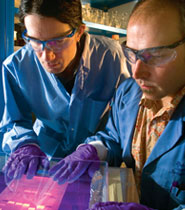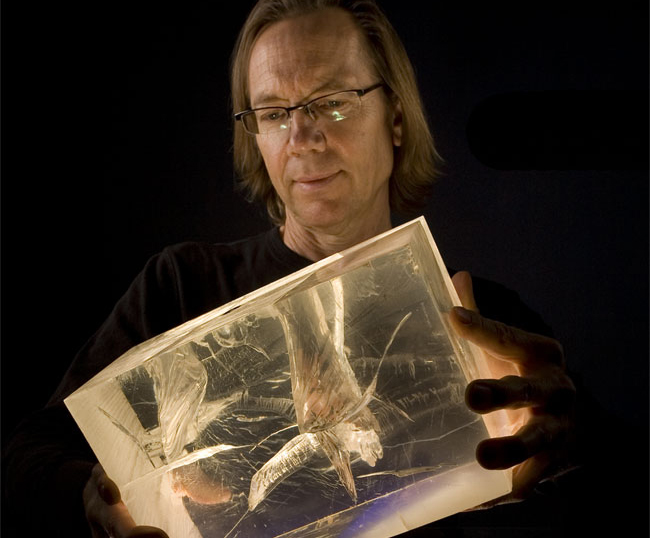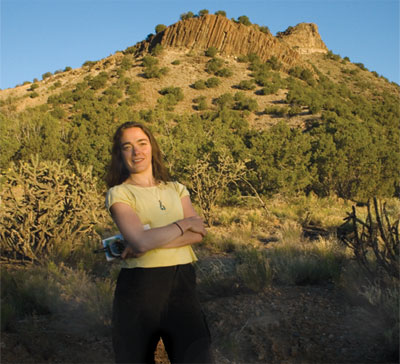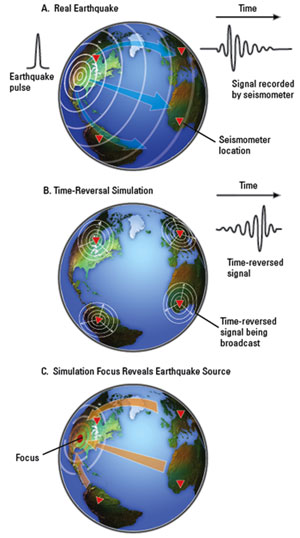
 1663
1663
|
|

RetrovisionReversing Time to Find Wave Sources
Paul Johnson examines the cracks and other defects buried within a translucent plastic block. His team is finding ways to use time-reversed sound waves to locate defects inside mechanical parts, as well as locate vibrational tremors within the earth. Tremors may prove to be the key to predicting when and where major earthquakes occur.
Retrace your steps. It's a good way to find lost items: your glasses, your keys . . . the TV remote. It can also be a good scientific way to find things. Just ask Paul Johnson. The Los Alamos geophysicist heads a team that uses time reversal—a technique that relies on the ability of waves to retrace their steps to their source—to find defects inside mechanical parts or to locate the sources of earthquakes deep underground. Time reversal is quite different from most techniques that use waves as locators. Consider radar, for example, which uses radio waves to track planes. A radar unit emits a brief pulse of radio waves in a beam that travels through the air, bounces off a plane, and returns to the unit's receiver. The speed of the waves is known, so one can use the round-trip time to calculate the distance to the plane. Moreover, the beam's position when it bounces off the plane can be used to calculate the plane's angular coordinates. Clearly, radar tracking involves a lot of calculating. By comparison, time reversal is a no-brainer, as Johnson points out. The waves that leave a source, travel through a medium, and that arrive at any number of sensor locations are recorded during a specified time interval. A set of time-reversed signals is then created by "flipping" the recorded signals: the last wave recorded becomes the first wave in the time-reversed signal. These new signals are then "broadcast" back into the medium from the same positions where they were recorded. Some time after the broadcast starts, major portions of the time-reversed waves converge back at the source—as if one had filmed the circular waves produced when a pebble is dropped into a pond and then had run the film backwards. If the source location is unknown, time reversal can usually find it. Moreover, if the recording captures the higher-frequency waves—those with short-enough wavelengths—time reversal can often reconstruct the source's physical extent and evolution in time with remarkable detail. 
Carène Larmat stands before a "Toreva block" located near the Rio Grande river, several miles east of Los Alamos. A long time ago, the block broke off from the peak seen behind it in the photo. Its impact with the ground produced a very small earthquake. Larmat uses time reversal and computer modeling to form images of the sources of earthquakes and other seismic events.
Time reversal achieves this great advantage over other wave-locator methods by using the information contained in all of the waves that reach a sensor during the recording interval, including waves of different types, waves that come directly from the source, and waves reflected from boundaries. Each recording therefore contains wave information also present in recordings from other sensors, as well as information that complements the information from other sensors. As the time-reversed waves converge on the source, the duplicated information adds up to form a high-amplitude wave, or "focus," at the source, while the complementary information fills in other details about the wave's shape. As a result, time reversal reconstructs the behavior of a source clearly and completely. Carène Larmat, a postdoctoral researcher who works with Johnson and Lianjie Huang, has used time-reversal simulations to find the sources of several major earthquakes (see box to right). Her work aligns with Los Alamos National Laboratory's national-security mission, which includes distinguishing natural seismic events from underground nuclear explosions. Time reversal may also allow scientists to measure the depth at which a nuclear explosion occurs, information that is usually hard to obtain. Johnson's team, however, is finding lots more applications. The technique can be used to find and image cracks and/or material separations (delaminations) in mechanical parts. The method is currently being developed as one of the many diagnostic techniques used to inspect weapons and could easily transfer to industry for examining machine parts. But the most-exciting application of time reversal may be to locate the weakly vibrating subterranean sources known as tremors—because tremors may be key to predicting large earthquakes. Earthquakes and TremorsFor more than a century, scientists have searched for a reliable way to predict large earthquakes. Strange clouds, radio emissions, water level in wells, unusual animal behavior, and more have been tried—but none have proved useful. However, a short article that appeared in the journal Science last January indicates that tremors—faint, low-frequency vibrations in the Earth that can last for weeks—could be the long-sought predictive signal.  Simulation showing time-reversed motion of the seismic waves produced by the 2004 Sumatra earthquake. Panels A–C show seismic waves beginning to converge, while D–E show the waves forming a strong focus (as indicated by the single pair of thick blue and red lines) at the earthquake’s source. At T = 0 seconds (Panel F), the fault began to rupture. Most of the seismic energy was released about 100 seconds later, which is why Panel E shows the most-intense focus of waves. Panels D and E also reveal that the source moved north. Other researchers observed the same source motion using existing source-location techniques.
"I never thought earthquake prediction would happen in my lifetime," says Johnson. "But the idea that tremors could be used to predict large earthquakes is being tested today, and we're in the thick of it." Tremors create waves that are often detected at the same time as low-frequency earthquakes, which are too small to do any damage themselves but sometimes appear just before a large earthquake. Thus, an increase in tremor activity could mean a "big one" is coming. However, finding tremor sources is difficult because the method now used on earthquakes doesn't work with tremors. Most earthquakes are associated with boundaries between tectonic plates, for example, in "subduction zones," where one tectonic plate, moving perhaps a couple of inches per year, serenely passes beneath another. The area where the two plates overlap is called a "subduction fault." At some point, parts of the plates stop moving because of increased friction over a region of the fault covering hundreds of square miles. Eventually, the mounting stresses overcome the friction, and the plates abruptly start moving again, releasing a huge pulse of energy and generating seismic waves that travel through the Earth and over its surface. Seismic waves can be detected thousands of miles from their source by a seismometer. In the seismometer's otherwise mostly flat output, an earthquake looks like a succession of "blips," each one signaling the direct arrival of a wave produced by the fault "rupture" or the delayed arrival of a wave reflected from one or more boundaries between layers in the Earth. To locate an earthquake's source, one first uses the blips to determine the difference between the direct arrival times of two types of wave: "shear" and "pressure" waves. Using that difference and a "velocity model," which describes how the speeds of the two types of waves change in the various media composing the Earth, one can then find the distance from the source to each station. Usually the distances from three or more stations are used to locate a source. The problem with trying to locate the source of a tremor is that a tremor signal has no blips. Instead, the signal is a nearly continuous, low-frequency tone or simple combination of tones lasting from minutes to days. With no clearly defined events in the seismic signal, it is impossible to find the source of a tremor in the usual way. Moreover, the signal can be almost too faint to be distinguished from "noise"—unwanted signals produced in a seismometer by such things as a passing truck or the wind. "In fact," Johnson says, "scientists first thought tremor signals were noise." Later, however, sophisticated techniques discerned subtle correlations between signals recorded at the same time but at different locations. The correlations indicated a common source—that of the tremors. Scientists have since determined that tremor signals often slowly emerge from the noise, then sink back into it. Larmat is optimistic that time reversal can locate the sources of tremor. While a postdoctoral researcher at the California Institute of Technology, Larmat used the technique to study glacial earthquakes that had recently been discovered in Greenland. Their signals, like tremor signals, are nearly buried in noise, but time reversal was able to locate their sources. Recently, Larmat ran a simulation and was able to find the source of a computer-generated tremor signal. She is about to try again, this time using real tremor data. Johnson is not surprised the method works so well. "Time reversal is incredibly robust," he says. "It's almost impossible for it not to work." Seeing Cracks and Delaminations
Time-reversed nonlinear-elastic analysis of a bearing cap reveals a crack (red spot at right) that is invisible to conventional acoustic techniques or x-rays.
Another member of Johnson's team, T. J. Ulrich, uses time-reversed sound waves to image cracks and delaminations in solid parts. The technique can detect damage invisible to existing sonic techniques or x-rays. The method evolved from Johnson's pioneering work in "nonlinear elasticity" and uses the fact that a part's response to sound energy is dramatically changed by cracks or other damage. To detect this change, Ulrich bathes an object in sound waves at two frequencies. This action makes the object "ring" like a bell. An intact object will ring at only the original two frequencies (a "linear-elastic" response). 
Laser vibrometer recording that shows time-reversed sound waves converging to a focus at a defect located within a special glass/metal block. The defect sits at the glass/metal interface, and the proof-of-principle experiment was designed to show that time-reversed sound waves could be used to find buried structures.
However, a damaged object will ring at many new frequencies as well because each damaged region responds in a nonlinear-elastic fashion. The two original waves become mixed at the damage sites and produce lots of new waves at many frequencies. Ulrich detects damage by seeing if any new frequencies show up. Of course, knowing that there's a crack or delamination somewhere in an object is not enough. It's best to actually see the damage. To do so, Ulrich has adapted a technique that Mathias Fink, the father of time reversal with sound waves, originally developed to find and destroy kidney stones. Ulrich simultaneously sends two wave pulses, each at a different frequency, into an object to make it ring. He then records the response with an array of sensors and filters the signal from each sensor to remove all but one of the new waves produced by damage in the object. For each sensor, he now has a signal whose sources are only the damaged regions. Time reversing and sending all the signals back into the object focuses acoustic energy on those sources. At the same time, Ulrich scans a laser vibrometer over the object's surface to measure how the surface moves, ever so slightly, up and down at each point. Since the damaged regions are now the focus of the sound energy, they vibrate more vigorously than the surrounding regions, bringing the location of cracks and delaminations to light. The Future
Members of the time-reversal team meet for morning espresso. Left to right: T. J. Ulrich, Carène Larmat, Michele Griffa, Paul Johnson, Pierre-Yves Le Bas, and Brian Anderson. Not shown are Los Alamos scientists Lianjie Huang and Jim TenCate and university collaborator Robert Guyer.
Johnson's team has also used sound pulses to measure the nonlinear-elastic response of bone. In this case, the "damage" providing the nonlinear-elastic response consists of microcracks. Microcracking makes bone fragile, a condition associated with osteoporosis, in which bones become more porous than normal. Initial experiments have shown the method to be far more sensitive to such damage than were existing measurement techniques. Moreover, the new technique does not use x-rays, which are currently used to detect bone density and indirectly infer bone integrity. Johnson tries not to get heady over the potential uses of time reversal. He notes that many aspects of the technique are not well understood, such as how the presence of the sensor affects the focus of the time-reversed signal. But aside from such subtleties, time reversal may, in the future, be used to find all sorts of things, including ways to prevent the disastrous outcomes of large earthquakes. —Brian Fishbine |

Key words- time reversal, earthquake prediction, tremor, non-linear elastic, elastic response, Mathias Fink 
 Using Time Reversal to Find the Source of an Earthquake A. An earthquake creates a relatively brief pulse of seismic waves. The waves fan out in all directions and can be recorded by faraway seismometers. Because they take different paths through the Earth’s various layers, some waves arrive at a seismic station later than others, and the recording produced by the seismometer is much longer than the original pulse. B. A time interval containing the earthquake data is chosen from each seismometer recording. The signals are loaded into a computer and flipped around in time so that waves that took the longest to arrive at the station become the first waves of the time-reversed signal. A computer simulation is then run, wherein the appropriate time-reversed signal is "broadcast" from each seismic station into a simulated Earth. Once again, waves fan out in all directions. C. As waves propagate out from each seismic station, portions retrace (in reverse) the original paths between that station and the earthquake source. These portions all arrive at the source location simultaneously. They combine and produce at that spot a wave with an enhanced amplitude, a focus in the overall wave pattern that marks the source location.
|